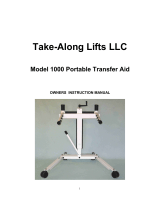Page is loading ...

StandDown
TM
SD-1 Wheelchair/Seat Monitoring System
INSTRUCTIONS – QUICK START GUIDE
StandDown is a completely self-contained chair
monitoring system. There are no plugs to connect,
wires to route, or alert units to locate. Simply position
the sensing pad, seat patient, and move the tamper
resistant slide selector to the ON position.
SYSTEM PLACEMENT
Locate Pad on seat while allowing the Monitoring
Controls (see Fig. B) to slide between the seat and
backrest. The small StandDown logo should now be in
the front/right corner of the
wheelchair seat. See Fig. A.
MONITORING
From the back of the wheelchair, with patient seated,
move the Slide Selector from the OFF position to the
ON position. Monitoring will automatically begin. See
Fig. B for Slide Selector location.
The system will not alarm as long as the patient remains
seated. If the patient attempts to stand, alarm will
sound. If the patient sits down again, alarm will stop,
the system will automatically reset, and monitoring will
resume.
If a patient is being escorted from the wheelchair to a
temporary non-wheelchair activity such as toilet duties
or shower, the slide selector may be moved to the
PAUSE position.
In PAUSE position, StandDown emits a steady low-
volume sound indicating that the system is “standing by”
and neither monitoring (ON) or completely out-of-service
(OFF). Pause setting will remind a caregiver to move
the Slide Selector back to ON position when the patient
has been reseated in the wheelchair. It is VERY
IMPORTANT to MAKE SURE that StandDown IS IN
THE ON POSITION when monitoring a patient.
END MONITORING SESSION
Locate slide selector and move it to the OFF position.
NURSE CALL SYSTEM MONITORING
Remote monitoring is possible when StandDown is
connected to a nurse call station using the optional
SD-NC cable. See Fig C.
StandDown will now continue to provide local alarm
while simultaneously sending an alarm signal to
central monitoring personnel.
If another device occupies the only available port on a
wall station, the optional SD-NCA adapter can be used
to enable dual inputs. See Accessories.
ALARM VOLUME
Alarm volume is adjustable. The volume adjustment
screw is located on the control flap between PAUSE
and the audio speaker.
Using a small flat tip screwdriver, gently turn the screw
clockwise to decrease volume or counterclockwise to
increase volume. See Fig. D
Fig. A
Fig. B
TM
Monitoring Controls
Slide Selector >
ON
PAUSE
OF
F
Fig. C
SD-NC

TESTING
Caregivers should test the StandDown system before
each use by applying pressure to the Pad with their
hand, moving the Slide Selector to ON, and then
removing hand pressure. If STANDDOWN fails to
alarm, immediate replacement is required.
CLEANING
StandDown may be cleaned with standard healthcare
disinfectants. Do not immerse in water.
STORAGE AFTER USE
The StandDown monitoring system may be loosely
rolled, or loosely folded for storage: FOLD OR ROLL IN
ONE DIRECTION ONLY. Please follow the instructions
on the bottom of the Pad to avoid damaging sensitive
electronics and voiding warrantee.
StandDown is best stored by first folding the Monitoring
Controls towards the Pad. This method keeps the
Monitoring Controls protected inside the roll or fold.
Please make sure the Slide Selector remains in the OFF
position when storing StandDown.
REPLACEMENT – 1 YEAR
Upon first use, caregiver’s should calculate a date
twelve months in advance and enter that date with
indelible pen in the white writing area provided on the
bottom of StandDown.
After twelve months, the disposable StandDown system
must be removed from service and replaced.
StandDown is environmentally friendly and may be
disposed of using standard methods for disposing
similar electronic devices.
SPECIAL NOTE TO CAREGIVER
StandDown is 100% Latex-Free.
ACCESSORIES (See Fig. E)
SD-NC
24-Foot Cable: StandDown to Nurse Call Station.
SD-NCA
6–Foot Y-Adapter: Nurse Call Station to SD-NC and a
second device.
High
Low
Fig. D
Fig. E
40 Years of Superior American Manufacturing
Made in U.S.A
U.S. and FOREIGN PATENTS
SD-NC
SD-NCA
REV. 07.10
SD-NC
SD-NCA
/



